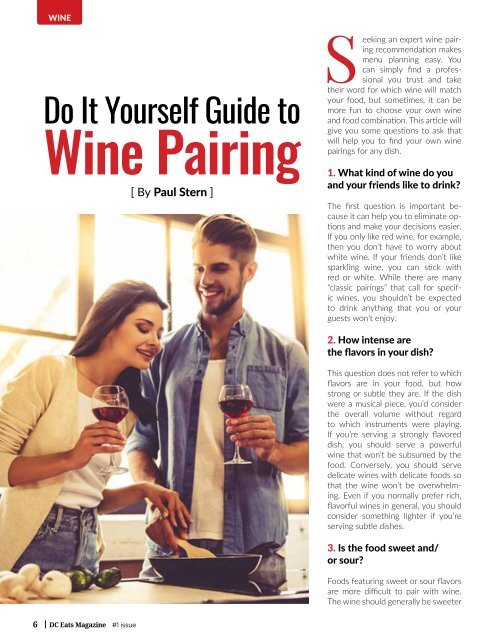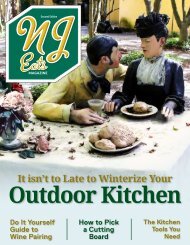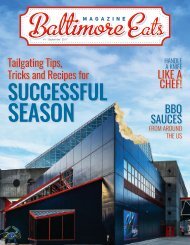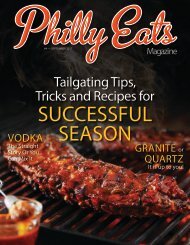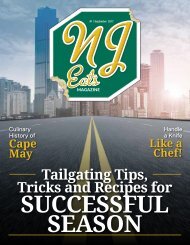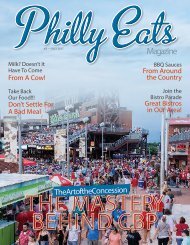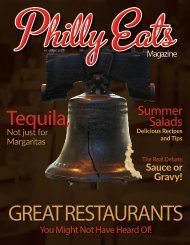DC Eats Magazine_First Issue_Update
The foodie magazine for the DC area.
The foodie magazine for the DC area.
You also want an ePaper? Increase the reach of your titles
YUMPU automatically turns print PDFs into web optimized ePapers that Google loves.
wine<br />
Do It Yourself Guide to<br />
Wine Pairing<br />
[ By Paul Stern ]<br />
Seeking an expert wine pairing<br />
recommendation makes<br />
menu planning easy. You<br />
can simply find a professional<br />
you trust and take<br />
their word for which wine will match<br />
your food, but sometimes, it can be<br />
more fun to choose your own wine<br />
and food combination. This article will<br />
give you some questions to ask that<br />
will help you to find your own wine<br />
pairings for any dish.<br />
1. What kind of wine do you<br />
and your friends like to drink?<br />
The first question is important because<br />
it can help you to eliminate options<br />
and make your decisions easier.<br />
If you only like red wine, for example,<br />
then you don’t have to worry about<br />
white wine. If your friends don’t like<br />
sparkling wine, you can stick with<br />
red or white. While there are many<br />
“classic pairings” that call for specific<br />
wines, you shouldn’t be expected<br />
to drink anything that you or your<br />
guests won’t enjoy.<br />
2. How intense are<br />
the flavors in your dish?<br />
This question does not refer to which<br />
flavors are in your food, but how<br />
strong or subtle they are. If the dish<br />
were a musical piece, you’d consider<br />
the overall volume without regard<br />
to which instruments were playing.<br />
If you’re serving a strongly flavored<br />
dish, you should serve a powerful<br />
wine that won’t be subsumed by the<br />
food. Conversely, you should serve<br />
delicate wines with delicate foods so<br />
that the wine won’t be overwhelming.<br />
Even if you normally prefer rich,<br />
flavorful wines in general, you should<br />
consider something lighter if you’re<br />
serving subtle dishes.<br />
3. Is the food sweet and/<br />
or sour?<br />
Foods featuring sweet or sour flavors<br />
are more difficult to pair with wine.<br />
The wine should generally be sweeter<br />
and more acidic than the food - otherwise,<br />
it will taste harsh or overly<br />
sour. So, for example, dishes<br />
with lemon or vinegar will pair<br />
well with tart wines, while foods<br />
with sugar or honey should pair<br />
nicely with sweet wines. Keeping<br />
all of this in mind, it becomes<br />
clear that higher acid wines with<br />
a slight sweetness are the most<br />
versatile for wine pairing.<br />
4. What is the fat content<br />
of your dish?<br />
Foods with higher fat content call<br />
for wines with higher tannins - the<br />
compounds found mainly in red wine<br />
that coat your tongue and teeth with<br />
a drying sensation. Tannins and fat<br />
soften and enhance each other. This<br />
is why tannic wines like Cabernet<br />
Sauvignon work so well with marbled<br />
meat, like steak.<br />
5. What are the main flavors<br />
in the food?<br />
Now we’re leaving intensity behind<br />
and asking about the character of<br />
the food’s flavor. Does your dish<br />
have a savory, meaty flavor, a fresh<br />
vegetable flavor, or subtle, briny seafood<br />
notes? The traditional European<br />
approach to wine pairing is to seek<br />
wines that have similar flavors to the<br />
Wine and food that<br />
originate in the same<br />
region tend to be<br />
a good match.<br />
dish. For example, you could pair lamb<br />
with mint alongside a Cabernet Sauvignon<br />
from Australia. The Cabernet<br />
has enough tannin to match the fat<br />
in the lamb, and Australian red wines<br />
are famous for flavors of eucalyptus,<br />
which has a green taste similar to the<br />
mint in the dish.<br />
For another example, think about<br />
pasta with butter sauce and toasted<br />
almonds. Chardonnay features both<br />
nutty and buttery flavors that would<br />
match the food well.<br />
6. Where is your dish from?<br />
There’s a famous saying: “what grows<br />
together, goes together.” This simply<br />
means that wine and food that originate<br />
in the same region tend to be<br />
a good match. Pasta with red sauce<br />
and Italy’s most popular red grape,<br />
Sangiovese, work very well together.<br />
The Alsace region in France produces<br />
wines that are great with pork - the<br />
mainstay of local cuisine. When in<br />
doubt, look for wines from the area<br />
that your dish comes from.<br />
7. Which course is<br />
the wine pairing for?<br />
If you find yourself with more than<br />
one possible wine for a particular<br />
dish, you can decide between them<br />
based on the course order. If you are<br />
serving salmon as a first course,<br />
you might consider a dry Rosé,<br />
but if it’s an entree, maybe a<br />
Pinot Noir would be better.<br />
Most of the time, lighters<br />
wines are served earlier<br />
in the meal, and sweet<br />
wines are served last<br />
with dessert. You can, of<br />
course, make exceptions<br />
if you want.<br />
8. Don’t be afraid<br />
I’ve heard it said that 80%<br />
of wine pairings are fine, 10%<br />
are great, and 10% are terrible.<br />
In my experience, this holds true -<br />
meaning that you have a 90% chance<br />
of finding a wine that’s at least okay<br />
- even if you guess. If, however, this<br />
article helps you find a truly wonderful<br />
pairing, you’ll be proud of yourself,<br />
impress your guests, and have a<br />
unique culinary experience. Have fun<br />
with the journey and let us know if<br />
you come across a top-notch pairing.<br />
Paul Stern has spent the last nine years<br />
in various roles in the wine industry,<br />
from tasting thousands of bottles in<br />
North Carolina to coordinating the<br />
wine pairings for some of Philadelphia’s<br />
elite restaurants. Before joining WTSO’s<br />
Product Development Team, Paul<br />
earned a certification with the Court of<br />
Master Sommeliers. Paul enjoys wine<br />
of all styles but has a particular love of<br />
lighter style reds and aromatic whites.<br />
6 <strong>DC</strong> <strong>Eats</strong> <strong>Magazine</strong> #1 issue<br />
#1 issue <strong>DC</strong> <strong>Eats</strong> <strong>Magazine</strong> 7


